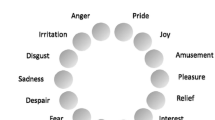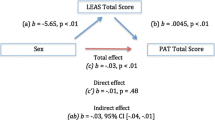Abstract
In this article, we report the development of a new test designed to measure individual differences in emotion recognition ability (ERA), five studies examining the reliability and validity of the scores produced using this test, and the first evidence for a correlation between ERA measured by a standardized test and personality. Utilizing Matsumoto and Ekman's (1988) Japanese and Caucasian Facial Expressions of Emotion (JACFEE) and Neutral Faces (JACNeuF), we call this measure the Japanese and Caucasian Brief Affect Recognition Test (JACBART). The JACBART improves on previous measures of ERA by (1) using expressions that have substantial validity and reliability data associated with them, (2) including posers of two visibly different races (3) balanced across seven universal emotions (4) with equal distribution of poser race and sex across emotions (5) in a format that eliminates afterimages associated with fast exposures. Scores derived using the JACBART are reliable, and three studies demonstrated a correlation between ERA and the personality constructs of Openness and Conscientiousness, while one study reports a correlation with Extraversion and Neuroticism.
Similar content being viewed by others
References
Allen, J. R., & Hamsher, J. H. (1974). The development and validation of a test of emotional styles. Journal of Consulting and Clinical Psychology, 42, 663–668.
Archer, D., & Akert, R. (1977). Words and everything else: Verbal and nonverbal cues in social interaction. Journal of Personality and Social Psychology, 35, 443–449.
Biehl, M., Matsumoto, D., Ekman, P., Hearn, V., Heider, K., Kudoh, T., & Ton, V. (1997). Matsumoto and Ekman's Japanese and Caucasian Facial Expressions of Emotion (JACFEE): Reliability data and cross-national differences. Journal of Nonverbal Behavior, 21 (1), 3–22.
Bruner, J. S., & Tagiuri, R. (1954). The perception of people. In G. Lindzey (Ed.), Handbook of social psychology, Vol 2. (pp.634–654). Reading, MA: Addison-Wesley.
Buck, R. W. (1976). A test of nonverbal receiving ability: Preliminary studies. Human Communication Research, 2, 162–171.
Buck, R. W., Savin, V. J., Miller, R. E., & Caul, W. F. (1972). Communication of affect through facial expressions in humans. Journal of Personality and Social Psychology, 23 (3), 362–371.
Costa, P. T., & M cCrae, R. R. Normal personality assessment in clinical practice: The NEO Personality Inventory. Psychological Assessment, 4, 5–13.
Cunningham, M. R. (1977). Personality and the structure of the nonverbal communication of emotion. Journal of Personality, 45, 564–584.
Darwin, C. (1872). The expression of emotions in man and animals. New York: Philosophical Library.
Ekman, P., Brattesani, K. A., O'sullivan, M., & Friesen, W. V. (1979). Journal of Nonverbal Behavior, 4 (1), 57–61.
Ekman, P., & Friesen, W. V. (1969). Nonverbal leakage and clues to deception. Psychiatry, 32 (1), 88–106.
Ekman, P., & Friesen, W. V. (1974). Nonverbal behavior and psychopathology. In R. J. Friedman & M. Katz (Eds.), The psychology of depression: Contemporary theory and research (pp. 3–31). Washington, DC: Winston & Sons.
Ekman, P., & Friesen, W. V. (1975). Unmasking the face. Englewood Cliffs, NJ: Prentice-Hall.
Ekman, P., & Friesen, W. V. (1978). Facial action coding system. Palo Alto, CA: Consulting Psychologists Press.
Ekman, P., & Friesen, W. V. (1986). A new pan-cultural expression of emotion. Motivation and Emotion, 10, 159–168.
Elmore, B. C. (1985). Emotionally handicapped comprehension of nonverbal communication. Journal of Holistic Medicine, 7, 194–201.
Eysenck, S. B., & Eysenck, H. J. (1968). The measurement of psychoticism: A study of factor stability and reliability. British Journal of Social and Clinical Psychology, 7 (4), 586–294.
Frank, M., & Ekman, P. (1997). The ability to detect deceit generalizes across different types of high-stake lies. Journal of Personality and Social Psychology, 72, 1429–1439.
Friedman, H. S., Prince, L. M., Riggio, R. E., DiMatteo, M. R. (1980). Understanding and assessing nonverbal expressiveness: The Affective Communication Test. Journal of Personality and Social Psychology, 39 (2), 333–351.
Hager, J. C., & Ekman, P. (1979). Long distance transmission of facial affect signals. Ethology and Sociobiology, 1, 77–82.
John, O. (1989). The BFI-54. Unpublished test, Institute of Personality and Social Research, Department of Psychology, University of California, Berkeley.
Lanzetta, J. T., & Kleck, R. E. (1970). Encoding and decoding of nonverbal affect in humans. Journal of Personality and Social Psychology, 16, 12–19.
LeRoux, J. A. (1987). Personality and the encoding and decoding of facial expressions of emotion. Unpublished doctoral dissertation, University of California, Berkeley.
Levy, P. K. (1964). The ability to express and perceive vocal communications of feeling. In J. R. Davitz (Ed.), The communication of emotional meaning. New York: McGraw-Hill.
Matsumoto, D. (1986). Cross-cultural communication of emotion. Unpublished doctoral dissertation, University of California, Berkeley.
Matsumoto, D. (1989). Cultural influences on the perception of emotion. Journal of Cross-Cultural Psychology, 20, 92–105.
Matsumoto, D. (1992). American-Japanese cultural differences in the recognition of universal facial expressions. Journal of Cross-Cultural Psychology, 23, 72–84.
Matsumoto, D., & Ekman, P. (1988). Japanese and Caucasian facial expressions of emotion (JACFEE) [Slides]. San Francisco, CA: Intercultural and Emotion Research Laboratory, Department of Psychology, San Francisco State University.
Matsumoto, D., & Ekman, P. (1989). American-Japanese differences in intensity ratings of facial expressions of emotion. Motivation and Emotion, 13 (2), 143–157.
Mill, J. (1984). High and low self-monitoring individuals: Their decoding skills and empathic expression. Journal of Personality, 52, 372–388.
Mufson, L., & Nowicki, S. Jr. (1991). Factors affecting the accuracy of facial affect recognition. The Journal of Social Psychology, 131, 815–822.
Nowicki, S. Jr., & Duke, M. P. (1994). Individual differences in the nonverbal communication of affect: The diagnostic analysis of nonverbal accuracy scale. Journal of Nonverbal Behavior, 18, 9–35.
O'sullivan, M. (1982). Measuring the ability to recognize facial expressions of emotion. In P. Ekman (Ed.), Emotion in the human face (pp.281–314). New York, NY: Cambridge University Press.
Riggio, R. E. (1986). Assessment of basic social skills. Journal of Personality and Social Psychology, 51, 649–660.
Riggio, R. E., & Friedman, H. S. (1982). The interrelationships of self-monitoring factors, personality traits, and nonverbal social skills. Journal of Nonverbal Behavior, 7, 33–45.
Rosenthal, R., Hall, J. A., DiMatteo, M. R., Rogers, P. L., & Archer, D. (1979). Sensitivity to nonverbal cues: The PONS test. Baltimore, MD: Johns Hopkins University Press.
Scherer, K. (1986). Vocal affect expression: Review and a model for future research. Psychological Bulletin, 99, 143–165.
Toner, H. L., & Gates, G. R. (1985). Emotional traits and recognition of facial expression of emotion. Journal of Nonverbal Behavior, 9, 48–66.
Trimboli, A., & Walker, M. (1993). The CAST test of nonverbal sensitivity. Journal of Language and Social Psychology, 12, 49–65.
Wallbott, H. G. (1992). Effects of distortion of spatial and temporal resolution of video stimuli on emotion attributions. Journal of Nonverbal Behavior, 16, 5–20.
Wolitzky, D. (1973). Cognitive control and person perception. Perceptual and Motor Skills, 36, 619–623.
Zuckerman, M., Hall, J. A., DeFrank, R. S., & Rosenthal, R. (1976). Encoding and decoding of spontaneous and posed facial expressions. Journal of Personality and Social Psychology, 34, 966–977.
Zuckerman, M., Larrance, D. T., Hall, J. A., DeFrank, R. S., & Rosenthal, R. (1979). Posed and spontaneous communication of emotion via facial and vocal cues. Journal of Personality, 47, 712–733.
Author information
Authors and Affiliations
Rights and permissions
About this article
Cite this article
Matsumoto, D., LeRoux, J., Wilson-Cohn, C. et al. A New Test to Measure Emotion Recognition Ability: Matsumoto and Ekman's Japanese and Caucasian Brief Affect Recognition Test (JACBART). Journal of Nonverbal Behavior 24, 179–209 (2000). https://doi.org/10.1023/A:1006668120583
Issue Date:
DOI: https://doi.org/10.1023/A:1006668120583




